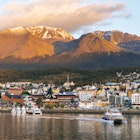
Dec 13, 2024 • 9 min read

Feb 5, 2025 • 8 min read

Torres del Paine National Park, Patagonia, Chile. Patrick Poendl/Shutterstock
The world’s most narrow and southern country packs a lot of everything into its slender form: Beautiful beaches, remote islands, towering mountains, colossal glaciers and fjords, fiery volcanoes, fertile valleys and lunar-like desertscapes – sometimes less than 150km (93.2 miles) apart from one another! A land of extremes if there ever was one, Chile runs the gamut of outdoor diversions. It’s not uncommon to ski pillowy powder in the morning and soak in the sun at the sea by the afternoon.
With the country’s diverse landscapes comes telecom challenges, though perhaps not as many as expected. While swaths of the Andes, Atacama and Patagonia can be dark, Chile is South America’s most well-connected country, with most regions boasting excellent mobile internet connectivity. Here’s a rundown on getting – and staying – connected with wi-fi, eSIMs and more while traversing Chile’s rapidly shifting panoramas.

¡Si! Chile operates on the GSM network, so all GSM-capable mobile devices will work in the country. But roaming internationally on our home country plans is shockingly expensive, especially considering how much data we now use daily while traveling (navigation, searching for hotels and restaurants, streaming, keeping in touch with loved ones back home etc). AT&T, for example, charges customers US$12 (CH$ 11,846) per day for unlimited high-speed data, talk, and text across more than 210 countries. Roaming from our home plans can certainly be convenient, but there’s questionable value considering the ease in which we can now obtain a local SIM (provided your phone is unlocked) and/or install an eSIM (on phones with eSIM capability).
, , , and are Chile’s main cellular service providers, which operate across a well-developed 3G, 4G LTE and 5G cellular network. Most of the country runs on 4G/4G LTE, with 5G limited to larger metropolitan areas and surrounds (Wom is currently the best for 5G coverage). Patagonia (between Puerto Montt and Punta Arenas) and the Atacama Desert (between Copiapó and Antofagasta) are the largest patches of spotty coverage throughout Chile, with miles and miles of dead zone throughout both.
To get connected with a pre-paid SIM/eSIM plan, expect to pay between US$2 (CH$2000) and US$5 (CH$5000), depending on the carrier/plan. Entel offers a 1GB, 15-day plan that includes 25 minutes for US$2 (CH$2000), Wom offers a similarly-priced plan with 50 calling minutes. With Claro, a similar plan is US$4 (CH$4000). Movistar offers the most substantial plan: 40GB plus 200 minutes for 30 days for US$5.05 (CH$4990). Of course, 1GB across 15 days isn’t going to get you very far if you're navigating with Google Maps and/or Waze throughout the day and streaming YouTube videos or films on Netflix by night. While bare-bones users can likely get by on 1-2GB per week, social media mavens are better off planning for 5-15GB per week to be safe.
Getting connected on the ground in Chile is fast and easy. All four cell phone carriers have physical shops around populated city centers (malls are safe bets); airport kiosks are less common. It’s best to avoid buying local SIMs from independent vendors such as unofficial kiosks, street touts and so on.
You aren’t likely to be asked for documentation for a pre-paid SIM/eSIM as a tourist in Chile for stays less than 30 days, but if you plan on using a Chilean SIM/eSIM for longer periods, foreigners are required to register their devices within 30 days of accessing the Chilean telecom network to avoid being blocked. Mobile service providers often take care of this process, known as , for you. If for some reason they don’t, you must register with a certifying company, validated by .
The main purpose of the registration process is to ensure your phone receives emergency messages sent by SENAPRED (SAE), Chile’s National Service for Disaster Prevention and Response. In this case, you will need a copy of your passport, your PDI Tarjeta de Turismo (Tourist Card; a small receipt given by immigration upon entering Chile) and a screenshot of your IMEI (International Mobile Equipment Identity number). This process is avoidable if you are using a pre-paid international eSIM.
Always seek the help of the sales associate for installing a local SIM/eSIM and do make sure you are connected before leaving the store (sometimes the initial connection processes can be convoluted and confusing for the uninitiated; or sometimes involve QR codes, requiring a second phone to implement).

Entel, Movistar and Wom offer eSIMs of early 2025 (despite offering the technology in Brazil, Argentina, Equador etc, Claro is still working on it in Chile). Chile also supports international eSIM services, so landing with a pre-installed eSIM is the most seamless way to hit the ground connected (we recommend as our eSIM partner; use code LP5 to receive 5% off your ). Costs to use Saily in Chile start as low as US$4.49 (CH$4356) for 1GB for seven days.
Using an eSIM in Chile offers maximum flexibility while traveling. If you use a physical SIM at home, you can keep it active while adding a Chilean eSIM. If you already use an eSIM with your home carrier, most phones support multiple eSIM profiles that can be easily switched – perfect for managing both home and travel connections on one device. Further, if you're traveling elsewhere in South America, eSIMs provide the flexibility to switch between different local carriers without the hassle of swapping physical cards.
At Santiago’s (SCL; Santiago), complimentary wi-fi is available within the terminal. Connect to "Airport WiFi – Free" and enter your email (signs say there is a 30-minute limit but it wasn’t true in our case). Wi-fi in coffee shops, restaurants and bars in hipper areas is common while ubiquitous in hotels, ł¦˛ą˛ú˛ąĂ±˛ą˛ő (cabins), hostels and most hospedajes (simple, family-run inns). The further you are from bigger cities, the less likely you’ll find wi-fi in public spaces, though Starlink is slowly becoming the go-to provider in more far-flung locales.
As with any public wi-fi connection, be weary of checking any sensitive information (online banking, password-protected accounts and so on) as your information is subject to hacking by cyber criminals.
Chile has a median download speed for fixed broadband country-wide of 274.46 Mbps, ranking top five in the world according to rankings by Speedtest.net (Singapore, United Arab Emirates and Hong Kong are most commonly faster). Cellular data speeds don’t fare quite as well, however, clocking in at 71st out of 147 tested countries with median cellular download and upload speeds of 38.30 Mbps and 13.38 Mbps, respectively.
Surprisingly, ValparaĂso, with an average download speed of 321.85 Mbps, is the city with the fastest fixed internet in the world, according to Speedtest Global Index’s late 2024 valuation of 200 cities worldwide.
Where present, the internet is stable and reliable throughout the country. However, as previously mentioned, Patagonia and the Atacama Desert are major dark spots.
Chile’s internet infrastructure is privately owned and operated and there are no government-imposed connectivity restrictions on internet access or social media platforms. Political, social and/or religious online content is not censored in anyway, making Chile one of the world’s most open online environments. The use of virtual private networks (VPNs) is legal and unrestricted as well.
Wi-fi isn’t common at major tourist sites outside of a few museums in Santiago, but data should work almost everywhere. save large chunks of Patagonia, Atacama and more remote islands in the South of Chile. Even the Lakes District's Caleta Condor, a massively isolated rural community only reachable by boat or a five-hour hike, has a data signal these days.

A bit of Spanish will go a long way with Chile’s cell phone service providers – you won’t find English-language websites, for example – but there is usually someone on hand at major carrier shops armed with basic English who can help connect you. English-speaking customer support isn’t common, but as with carrier shops, there is potential to be passed along to an English speaker or an online chat option, in which case you can use online services like Google Translate or DeepL to get the job done.
Staying connected in Chile is very affordable. At its best deal (Movistar’s 40GB per month plan), getting online costs as little as US$0.12 (CH$118) per GB. With Entel, Claro and Wom, costs are higher at US$2 (CH$1974) per GB. International options are pricier – options like can run as low as US$4.49 (CH$4356) per GB – but of course, there is a convenience factor to consider as well as a price for taking the time to go to a local shop, deal with language barriers, etc. Unless you have a unique international roaming deal (such as T-Mobile’s international roaming-inclusive postpaid plans in the USA), roaming internationally on your home plan is almost always a vacation-ruining expense.
Chile’s electricity current operates on 220V, 50Hz. Electrical sockets have two or three holes and accept round (European) plugs. The only etiquette regarding cellular phones in Chile is that there is no etiquette – Chileans prefer a cellular free-for-all approach. Locals also prefer audio messages to texts, so keep that in mind when messaging folks.
For emergency services, Chile has separate numbers depending on the nature of the emergency:
Police: 133 | Fire: 132 | Ambulance: 131
Eventrid: Widely used for local culture and entertainment listings across Chile.
Recorrido.cl: Nationwide bus ticket booking and comparison featuring Chile’s most popular bus companies.
This article was produced by ĚÇĐÄ´«Ă˝ as part of our partnership with Saily. ĚÇĐÄ´«Ă˝'s advice and opinions are solely our own.


Dec 13, 2024 • 9 min read


Nov 21, 2024 • 5 min read

Sep 12, 2024 • 9 min read


Jul 31, 2024 • 4 min read


